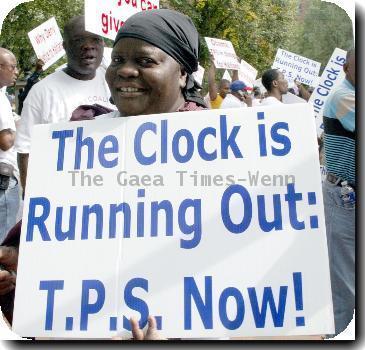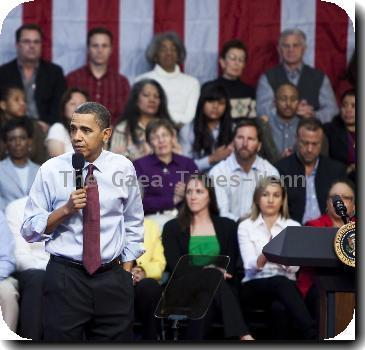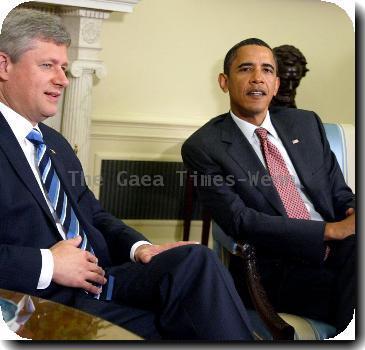How a derivative, little-understood but key to financial system, circles the world
By Bernard Condon, APMonday, June 7, 2010
Brazil to your bank: How derivatives circle globe
NEW YORK — Jonis Assmann, who grows soybeans on a farm in Brazil, is not sure exactly how financial derivatives work. But he’s counting on them to help bring in next year’s harvest.
Assmann is perpetually worried he will run short of cash if prices for his crops fall. So he tries to pay for some of his supplies at the start of the growing season with a fixed amount of soybeans that will be collected at the end.
His suppliers don’t want to take on the risk of falling prices, either. But last month Philadelphia chemical maker FMC Corp. agreed to send Assmann all the insecticides and herbicides he needs in exchange for a third of his expected harvest.
Making the barter possible: A separate derivative that FMC, without Assmann’s knowledge, got a bank to design. That side bet is designed to make sure FMC won’t lose a penny if soybean prices fall.
“They seem very complicated,” Assmann, 39, said when told about the derivative. “A poultry company here lost a lot of money in derivatives. I don’t fully understand them.”
Neither do most people, even though trade in many things we buy every day would slow or even stop without them.
Derivatives are private bets between two parties on how the value of assets like crops or measures like interest rates will change in the future. Most aren’t traded on exchanges, and they’re hard to value.
There’s a derivative for nearly everything. You can bet that the Standard & Poor’s 500 index will be higher in a year or the dollar will fall in value. You can bet that people of a certain age will die off faster than expected. A few creative financiers once devised a derivative that allowed you to bet on the value of future royalties from old David Bowie songs. Others came up with one to bet on how many basketball games the Utah Jazz would win in a year. And, yes, you can bet on soybeans in all their varieties — crushed or ground, solid or oil, normal-sized or miniature.
For all the positives that investors see in derivatives, the investments can also be dangerous. Dubbed “financial weapons of mass destruction” by billionaire Warren Buffett, derivatives have been behind nearly every recent financial blowup from the bankruptcy of Orange County, Calif., in 1994 to the collapse of the housing market.
Two years after panic on Wall Street brought the economy to near-collapse, Congress is finalizing a sweeping overhaul of laws governing the financial services industry. Legislation is pending that would regulate derivatives for the first time — and could make derivatives like FMC’s difficult to execute. House and Senate negotiators will begin crafting the final bill this week. President Barack Obama hopes to sign it into law by July 4. Both the House and Senate versions would require users or middlemen to set aside money in case their derivatives generate big losses.
Supporters of the legislation say regulation is needed to prevent another meltdown. But opponents say regulation will make it too expensive for companies such as FMC to hedge their risk and will throw sand into the gears of commerce. That’s because derivatives affect the price of nearly everything we buy — a steak at a restaurant, bread at the supermarket, gas for our cars.
“There isn’t a thing you use that isn’t somewhere hedged by derivatives,” said Lee Prisament, a doctor who ditched medicine 20 years ago to design derivatives at banks like JPMorgan Chase & Co. “The average Joe benefits from them without even knowing it.”
Derivative contracts worldwide have a value of $700 trillion, or 10 times the worth of all the goods and services produced in the world in a year. Speculators are behind much of this market. But derivatives’ popularity also reflects fear at companies that they could get walloped by unexpected changes in the prices of things they buy or sell.
In the case of the Brazilian soybeans, the fear showed up in a most unlikely person.
Scion of a proud farming family of German descent, Assmann greets visitors with a firm handshake and exudes confidence when talking about business. He boasts that he’s “usually 80 percent right” guessing where soybean prices are heading. But that other 20 percent can sock him with big losses.
Five years ago, Assmann was caught by surprise when prices for soybeans dropped on world markets. He lost $1 million, had to lay off a dozen workers and found himself scrambling for cash to pay suppliers, including makers of herbicide and insecticide. This year, because of the crops-for-chemicals deal, Assmann hopes his scrambling days are over.
On a sunny day in April, Marina Fusco, an FMC analyst in Brazil, grabbed her laptop and jumped in a pickup for a four-hour drive to Assmann’s farm in the big agricultural state of Mato Grosso do Sul, west of Sao Paulo. She was ushered into his office to answer a seemingly simple question: If FMC’s chemicals cost $660,000, just how many bushels should he eventually hand over?
The answer isn’t easy because Assmann will start planting in November and won’t harvest until May next year. It’s anyone’s guess what the price of soybeans will be then. The soybean futures market at the Chicago Board of Trade provides one clue. But futures fluctuate every second, and those changes over tens of thousands of bushels can translate into big money.
So Fusco and Assmann haggled, stealing glances at their computers to check prices for Chicago futures due in May 2011. Fusco threw out a few numbers and fired off a half-dozen e-mails to staffers at her Brazilian office and in Philadelphia to double-check her math. After an hour, the two agreed to value the soybeans at roughly $10 a bushel regardless of what the market price is next year. Translation: Assmann would have to hand over 66,000 bushels in exchange for FMC’s chemicals.
The two signed a single-page contract stipulating terms like the warehouse to which Assmann must send the soybeans when they’re harvested. Now it was up to one of Fusco’s colleagues in Philadelphia, Julian Treves, to prevent FMC from losing money if soybeans are worth less than $10 a bushel when the company receives Assmann’s crop. Here is where derivatives come into the story.
Treves called Citigroup Inc. in Houston. Within 10 minutes, he agreed to pay Citi $3,000 to design a derivative to protect FMC. If the price of soybeans is below $10 in a year, Citi must pay the difference to FMC. If the price is above $10, FMC must give the difference to Citi.
Banks like Citi, in turn, typically transfer their risk by finding a company that regularly buys soybeans and wants to lock in prices a year ahead of time at $10. In Wall Street parlance, FMC and Citi are hedged — protected against the hard-to-predict price fluctuations.
Even the harshest critics of derivatives are fans of such hedging. Locking in a stable price for a key raw material allows a manufacturer or a retailer to avoid raising prices on a host of products, from coffee at Starbucks Corp. to clothes at a department store.
“You shouldn’t tar all derivatives with the same brush,” said Frank Partnoy, a former derivatives trader who lashed out at them in his book “Infectious Greed.” ”It’s hard to think of the world without them.”
The problem is, derivatives can also be used to gamble. That’s because you don’t have to own the asset that a particular derivative tracks. Say that FMC just had a hunch that soybean prices would fall. It could have entered into soybean futures contracts in hopes of making a little money on the side.
American International Group Inc. nearly collapsed in 2008 thanks to such side bets. Though largely an insurer, AIG gambled hundreds of billions via derivatives that homeowners with bad credit would continue making payments on their mortgages. What’s more, it didn’t set aside much money in case it was wrong and had to pay parties that took the other side of the bet that these homeowners would stop paying.
When homeowners did stop paying during the housing crash, AIG suffered huge losses. Taxpayers had to fork over $182 billion to keep the company afloat.
The financial overhaul bills passed by the Senate and the House won’t outlaw the kind of speculation AIG did. But they will force AIG and many other derivative users to put money aside. The goal is to prevent another financial meltdown.
The Senate version would require banks that take people’s deposits or borrow from the Federal Reserve to put their derivatives-trading units into separately funded subsidiaries walled off from their other businesses. The House version would not. In addition, both bills would replace many private deals like FMC’s with one-size-fits-all contracts that trade on public exchanges where everyone could see prices. The two versions would allow some companies that are hedging, not gambling, to continue with their customized deals.
If FMC were forced to use an exchange, it would be able to hedge soybeans only in standardized units of 5,000 bushels. Thus it could have hedged only 65,000 bushels, not the 66,000 it will own after Assmann’s harvest. That would have left FMC exposed to losses on a 1,000 bushels if prices fell under $10 in a year. Since FMC has struck similar deals with dozens of other Brazilian farmers, the losses could add up.
Also, many standardized contracts only allow hedging on prices for certain months in the future. In the case of soybeans, FMC can enter into contracts that expire in May 2011 when Assmann harvests his crops but not in four other months of the year. Some of the farmers bartering with FMC harvest their crops later in the long Brazilian growing season during months for which standardized contracts don’t exist.
Finally, the two bills would force bank middlemen, like Citi in FMC’s case, to set aside money in case either party to a derivative can’t pay up.
“If Citi has to hold higher reserves, Economics 101 says they’ll pass those costs on to us,” said FMC treasurer Tom Deas.
Despite the likely change in rules, derivatives will remain popular. The fear of something going wrong, and the desire to hedge against it, is just too powerful.
Since his barter with FMC, Assmann’s fear of falling prices has started to come true. Investors on the Chicago Board of Trade now predict soybeans in May 2011 will fetch closer to $9 than $10. Says the otherwise confident farmer, “You can never be 100 percent sure.”
Tags: Barack Obama, Brazil, Chicago, Commodity Markets, Holidays, Illinois, Latin America And Caribbean, Materials, New York, North America, Occasions, South America, United States



